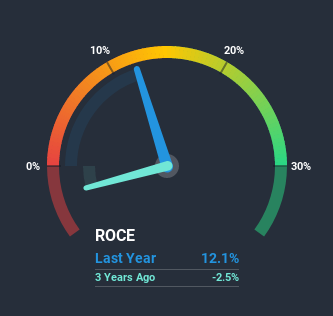- India
- /
- Paper and Forestry Products
- /
- NSEI:BALLARPUR
Here’s What’s Happening With Returns At Ballarpur Industries (NSE:BALLARPUR)

If you're not sure where to start when looking for the next multi-bagger, there are a few key trends you should keep an eye out for. In a perfect world, we'd like to see a company investing more capital into its business and ideally the returns earned from that capital are also increasing. Basically this means that a company has profitable initiatives that it can continue to reinvest in, which is a trait of a compounding machine. So when we looked at Ballarpur Industries (NSE:BALLARPUR) and its trend of ROCE, we really liked what we saw.
Return On Capital Employed (ROCE): What is it?
Just to clarify if you're unsure, ROCE is a metric for evaluating how much pre-tax income (in percentage terms) a company earns on the capital invested in its business. The formula for this calculation on Ballarpur Industries is:
Return on Capital Employed = Earnings Before Interest and Tax (EBIT) ÷ (Total Assets - Current Liabilities)
0.12 = ₹3.5b ÷ (₹112b - ₹84b) (Based on the trailing twelve months to December 2019).
Therefore, Ballarpur Industries has an ROCE of 12%. In absolute terms, that's a satisfactory return, but compared to the Forestry industry average of 9.4% it's much better.
View our latest analysis for Ballarpur Industries

While the past is not representative of the future, it can be helpful to know how a company has performed historically, which is why we have this chart above. If you want to delve into the historical earnings, revenue and cash flow of Ballarpur Industries, check out these free graphs here.
How Are Returns Trending?
We're pretty happy with how the ROCE has been trending at Ballarpur Industries. The data shows that returns on capital have increased by 164% over the trailing five years. That's a very favorable trend because this means that the company is earning more per dollar of capital that's being employed. Speaking of capital employed, the company is actually utilizing 64% less than it was five years ago, which can be indicative of a business that's improving its efficiency. A business that's shrinking its asset base like this isn't usually typical of a soon to be multi-bagger company.
On a side note, we noticed that the improvement in ROCE appears to be partly fueled by an increase in current liabilities. Essentially the business now has suppliers or short-term creditors funding about 74% of its operations, which isn't ideal. Given it's pretty high ratio, we'd remind investors that having current liabilities at those levels can bring about some risks in certain businesses.What We Can Learn From Ballarpur Industries' ROCE
In a nutshell, we're pleased to see that Ballarpur Industries has been able to generate higher returns from less capital. Although the company may be facing some issues elsewhere since the stock has plunged 92% in the last five years. In any case, we believe the economic trends of this company are positive and looking into the stock further could prove rewarding.
Ballarpur Industries does come with some risks though, we found 4 warning signs in our investment analysis, and 1 of those is potentially serious...
While Ballarpur Industries may not currently earn the highest returns, we've compiled a list of companies that currently earn more than 25% return on equity. Check out this free list here.
When trading Ballarpur Industries or any other investment, use the platform considered by many to be the Professional's Gateway to the Worlds Market, Interactive Brokers. You get the lowest-cost* trading on stocks, options, futures, forex, bonds and funds worldwide from a single integrated account. Promoted
Valuation is complex, but we're here to simplify it.
Discover if Ballarpur Industries might be undervalued or overvalued with our detailed analysis, featuring fair value estimates, potential risks, dividends, insider trades, and its financial condition.
Access Free AnalysisThis article by Simply Wall St is general in nature. It does not constitute a recommendation to buy or sell any stock, and does not take account of your objectives, or your financial situation. We aim to bring you long-term focused analysis driven by fundamental data. Note that our analysis may not factor in the latest price-sensitive company announcements or qualitative material. Simply Wall St has no position in any stocks mentioned.
*Interactive Brokers Rated Lowest Cost Broker by StockBrokers.com Annual Online Review 2020
Have feedback on this article? Concerned about the content? Get in touch with us directly. Alternatively, email editorial-team@simplywallst.com.
About NSEI:BALLARPUR
Ballarpur Industries
Ballarpur Industries Limited, together with its subsidiaries, manufactures, sells, and exports writing and printing paper, and pulp products in India and internationally.
Weak fundamentals or lack of information.
Market Insights
Community Narratives



